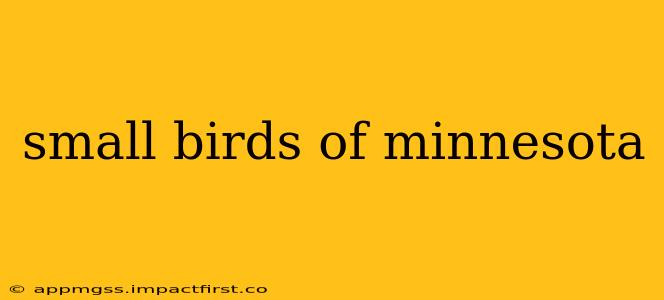Minnesota, with its diverse habitats ranging from prairies and forests to wetlands and lakes, is home to a vibrant array of bird species. Many of these are small birds, often overlooked but incredibly fascinating. This guide delves into the world of Minnesota's tiny feathered friends, exploring their identification, habitats, and behaviors. Whether you're a seasoned birder or just beginning your avian adventures, this resource will help you appreciate the beauty and diversity of these captivating creatures.
Identifying Small Birds in Minnesota: Key Features
Identifying small birds requires careful observation. Size alone isn't enough; you need to consider plumage, beak shape, behavior, and habitat. Here are some key features to look for:
- Size and Shape: While "small" is relative, pay attention to the bird's overall size compared to familiar birds like robins or sparrows. Note the body shape – is it slender, plump, or compact?
- Plumage: Coloration is crucial. Look at the overall color, any markings (stripes, spots, patches), and the color variations between males and females.
- Beak Shape: The beak's shape reflects the bird's diet. A long, thin beak often indicates an insectivore, while a shorter, conical beak might belong to a seed-eater.
- Habitat: Where you see the bird is a significant clue. Different species prefer different environments – forests, fields, wetlands, etc.
- Behavior: Observe the bird's behavior – how it forages, flies, and interacts with its surroundings.
What are some common small birds found in Minnesota?
Several small bird species are frequently sighted across Minnesota's diverse landscapes. These include:
- Chickadees: These tiny, active birds are easily recognized by their black caps and bibs, and their cheerful "chick-a-dee-dee-dee" call. They are common year-round residents in various habitats.
- Wrens: Minnesota boasts several wren species, including the House Wren, known for its busy, energetic nature and its preference for nesting in cavities.
- Kinglets: These are incredibly small, active birds with olive-green or grayish plumage. They are often found in coniferous forests.
- Warblers: Minnesota hosts numerous warbler species during migration, with many exhibiting vibrant plumage and distinctive songs. They are often found in woodlands and shrublands.
- Sparrows: Various sparrow species are common year-round residents, exhibiting subtle plumage variations that help distinguish them. They're often found in fields and open areas.
What are the smallest birds in Minnesota?
Determining the absolute smallest bird in Minnesota can be tricky as size can vary slightly, but the Golden-crowned Kinglet and the Ruby-crowned Kinglet are consistently among the contenders for the title of smallest. Their diminutive size and active foraging behavior make them a challenge to spot but a rewarding find for birders.
Where can I find small birds in Minnesota?
The best places to find small birds in Minnesota depend on the species you're looking for and the time of year. However, some excellent locations include:
- State Parks and Wildlife Management Areas: These areas often provide diverse habitats supporting a wide range of bird species.
- Local Parks and Green Spaces: Even urban areas can offer surprising opportunities for birdwatching.
- Nature Centers and Bird Sanctuaries: These dedicated locations often provide excellent viewing opportunities and educational resources.
What do small birds in Minnesota eat?
The diets of Minnesota's small birds vary greatly depending on the species. Many are insectivores, feeding on insects, spiders, and other small invertebrates. Others are granivores, consuming seeds and grains, while some are omnivores, incorporating both plant and animal matter into their diet.
How can I attract small birds to my backyard?
Creating a bird-friendly backyard is a rewarding way to enjoy the beauty of these small birds up close. Here are some tips:
- Provide food sources: Offer a variety of birdseed blends, suet, and mealworms.
- Install bird feeders: Choose feeders appropriate for different types of seeds and birds.
- Offer fresh water: Birds need a reliable source of fresh water for drinking and bathing.
- Plant native vegetation: Native plants provide food, shelter, and nesting sites.
By understanding the characteristics, habitats, and behaviors of Minnesota's small birds, you can embark on exciting birding adventures and gain a deeper appreciation for the avian wonders that surround us. Remember to always observe birds responsibly, maintaining a respectful distance and minimizing disturbance to their natural habitats.
